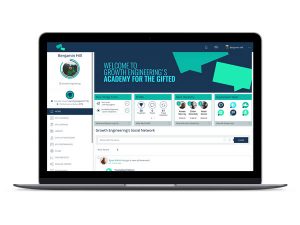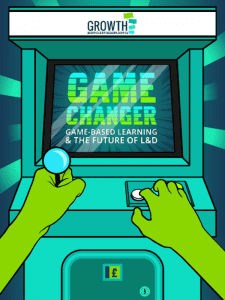A learning portal is an online gateway to a better version of yourself. Think of it as a magic window that lets you see into the future. Once you step through that learning portal, you can gain the superpowers you need to go further, reach higher and simply become even more awesome!
If that sounds too sci-fi for you, maybe you’d prefer a more practical learning portal definition.
In its simplest terms, a learning portal is a website or an online archive. It could be a microsite within an intranet or a dedicated secure learning platform.
Let’s say you’ve started a new job and you need to access all your training materials. With a learning portal, you simply enter the URL in your browser, fill in your user name and password and you’ll unlock an electronic database containing all you need to know.
Learning Portal Content
The content itself can take many forms. It can range from manuals to game-based simulations, but between those extremes, there are plenty of other ways to get a learning objective across. When most people think of online training content, eLearning will be the first thing that springs to mind.
Traditionally, eLearning content is little more than a slideshow with a few multiple-choice questions added. Although this is slightly more exciting than a simple document, it can still be rather dull and corporate. It’s for this reason that eLearning (and online learning in general) has earned a pretty grim reputation for being ineffective and more hassle than it’s worth.
That’s not to say that eLearning is a bad idea in itself – but we’ll come back to that later.
A Brief History of Learning Portals
As long as computers have existed, training departments have used them to cut down on paper and make their training seem more dynamic and up to date. Universities and other educational bodies would have their own internal databases. This made it easier for students to find the information they needed. It wasn’t until the internet became popular that the learning portal became a popular feature in other sectors.
A Cheaper Alternative to Classroom Training
 Online learning portals proved a big money saver for businesses in the 1990s. Prior to that, organizations had to rely on face-to-face training and classroom sessions. From a logistical standpoint, these took time, effort and money to organise and costs would frequently balloon out of control.
Online learning portals proved a big money saver for businesses in the 1990s. Prior to that, organizations had to rely on face-to-face training and classroom sessions. From a logistical standpoint, these took time, effort and money to organise and costs would frequently balloon out of control.
Because there were no realistic means to reinforce this training, it was largely forgotten within a couple of weeks. Nobody would have dared admit it, but most employees would view these training sessions as an excuse to take a day off work.
Diagnosing the Engagement Problem
Once online learning portals came into effect, the employees could access the training from their own computers, even outside of working hours. They couldn’t replace face-to-face training completely, but they provided an alternative when classroom training wasn’t strictly necessary. With that problem solved, another soon came to light – how do you get people to use a learning portal?
Throughout the early 2000s (and to some extent, even today), learning portals were still seen as online archives. There were, however, a few pioneering learning technology developers who made an important observation. If a learning portal is to have any success at all, it needs to engage the users and make them want to use it.
Learning Portals and Engagement
You can lead a horse to water, but you can’t make it drink. So goes the old saying, but with an uninspiring learning portal, you can’t even lead the users to it. With some learning technology companies charging exorbitant fees for glorified online directories, organizations were wasting millions every year on platforms that nobody even wanted to use.
Once they started to focus more on user engagement, everything changed. That ineffective click-through slideshow eLearning of the past took a back seat, making way for learning games, training campaigns and bite-sized content. Developers began to concentrate on creating more engaging learning portals including various features:
Gamification
 Around 2004, game mechanics like badges, experience points, levels and leaderboards appeared in learning portals. Behind these seemingly frivolous features was some serious psychological study. In simple terms, people are more likely to do something if they enjoy the experience.
Around 2004, game mechanics like badges, experience points, levels and leaderboards appeared in learning portals. Behind these seemingly frivolous features was some serious psychological study. In simple terms, people are more likely to do something if they enjoy the experience.
Personalisation
Everybody knows that the sheep-dip approach to learning doesn’t work. It makes you wonder why so many people still use it! Personalisation features were added to learning portals to give learners an environment that they could call their own. It also ensured that they found the content that was relevant to them, without having to wade through an entire database.
Social Learning
Social features landed on learning platforms with an almighty crash. Although they were initially added to help users learn from each other, they had huge consequences outside of mere learning and development. By improving communication and giving employees opportunities for public recognition, they’ve had measurable effects on the culture of entire organisations.
Mobile Learning
As technology evolved, developers needed to make sure that the learning portal grew with the needs of the users. Today more people use mobile devices than desktop computers. It would have been a major oversight to ignore this trend. Now more and more developers are ensuring that their learning portals are mobile responsive and in some cases, they’re developing exclusively mobile learning platforms.
The Future of Learning Portals
By creating more engaging learning portals, their true potential is coming to light. It’s very possible that the learning portal, as we know it, will cease to exist. In the future, these platforms might become comprehensive engagement solutions. Learning and development will still be a major function, but it will become part of a more holistic approach.
These new learning portals will take into account the interconnected nature of all organisations, whether they’re big businesses, universities or government bodies. We can only hope that when these new systems start making the world a better place, everyone will remember that it was the learning and development community that came up with the idea!
Find out how to turn your learning portal into something so very much more by clicking the button below!









